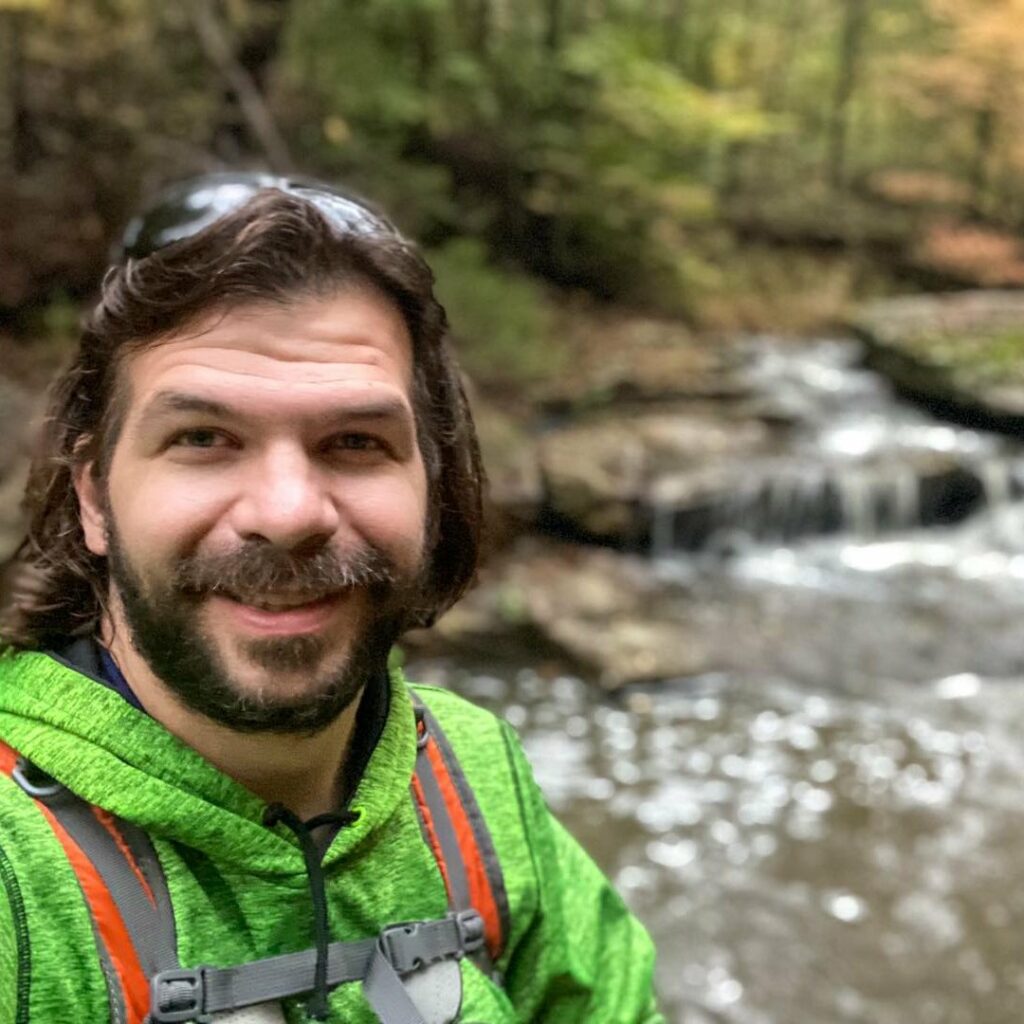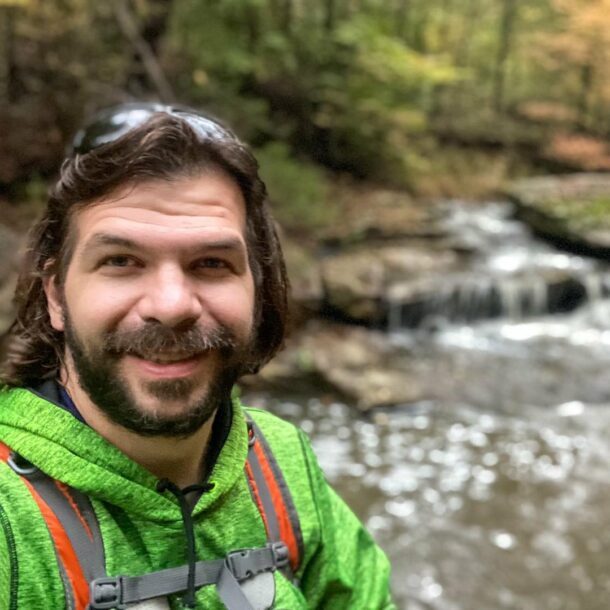Giant City Trillium Trail Guide
Giant City Trillium Trail is a popular trail located near Makanda in Southern Illinois.
Trillium Trail is a part of Giant City State Park. The trail is also known as Fern Rocks Nature Preserve. As a designated nature preserve, it is important to note that hiking is only permitted on the designated trail. Precious flora, plants, and wildlife exist on the trail, and off-trail use could negatively impact their ecosystems.
This loop trail is popular among hikers, trail runners, and people wanting exercise. The trail is easy to reach and easy to follow.
This Giant City Trillium Trail guide will show you everything you need to know to enjoy this fantastic trail.
Directions to Giant City Trillium Trail
Getting to Trillium Trail is easy.
From Carbondale, take Giant City Road south of Highway 13 for 10 miles. Giant City Road will turn into the state park road. Once you enter the park, turn RIGHT on S Church Road before passing the Visitor Center. Drive to the second left turn and turn LEFT to go down the hill (by the dumpers) and onto Stonefort Road. Turn RIGHT onto Stonefort Road. Drive 2 miles until you see Trillium Trail on your left. If you reach Makanda Road, you’ve gone too far.
Trillium Trail Parking Lot GPS Coordinates: 37.624973, -89.203752
Get directions to Giant City Trillium Trail from Chicago, St. Louis, Nashville, or Indianapolis.
There is a small parking lot at the trailhead. It fits about eight to ten vehicles. More parking space is available at Shelter One, a little east of Trillium Trail.
All roads leading to Trillium Trail are paved. Any vehicles should be able to reach this trail. The parking areas are gravel.
WINTER TRAVEL: During wintry conditions (snow and ice), the roads within Giant City State Park may not always be treated or plowed before primary roads. Please use caution when visiting during wintry conditions and have a Plan B if visiting is impossible.
PUBLIC HEALTH: Pay attention to the Illinois Department of Natural Resources (IDNR) website for the latest information on public health closures and restrictions for Illinois State Parks.
Trail Information for Giant City Trillium Trail
Trillium Trail consists of a 1.7-mile loop trail. It should take you 30 minutes to 1-hour to finish the trail.
There is right under 250’ of max elevation. The hill up the bluff is a little strenuous, but the distance is short.
It’s best to hike clockwise. Going up and down the upper trail is safe, but please watch your step and take your time to enhance your safety.
There are no trail markers or blazes, but the trail is well-used and obvious to follow. User-created side trails typically have signs asking that you stay on the designated trail. As a Nature Preserve, you should follow these directions to help protect the precious botanical elements and wildlife that depend on these ecosystems.
TRAIL HAZARDS: There are some hazards along the Giant City Trillium Trail that you should note.
- During rainy or wintry conditions (snow and ice), the trail could be dangerous to hike. High cliffs, creeks, hills, and areas will be slick. Please use extreme caution if you hike this trail during rainy or wintry conditions.
- Be careful around the edges of the bluffs on the top side. Some of them lean, and the ground around them can be unstable. Falling from those heights will likely result in death.
- Poison ivy and sticker bush occur alongside the trail in some spots. Remain on the trail to avoid most of these plants. Wash off with cold soapy water after your hike to get any oils off your skin.
- Venomous copperhead snakes may be present during warmer months. To avoid contact with snakes, watch your step and stay on the designated trail. If you encounter any snake, walk a safe distance around it. You might have to step off the trail to get around it. Just make sure it’s safe to do so. It is unlawful to handle, harass, or harm snakes on state park property.
- During warmer months, ticks, mosquitoes, and biting flies may occur on the trail. Protect yourself from these pests by using repellent, than uses DEET. Treat your clothing and gear with Permethrin to help prevent ticks. Check yourself thoroughly for ticks after your hike.
- Make sure you stay hydrated while using the trial. During warmer weather, hike slowly and take a break in the shade if you start to feel too hot.
What You Will See along the Trillium Trail Hike
There is a lot to see for such a short trail while hiking it, no matter what season you choose to visit.
You might try to hike it during each season to see something different each time.
During the winter months, you can enjoy more visibility of the bluffs, natural shelters, and rock formations that the preserve offers. If the area is wet, you might even see a frozen waterfall or amazing icicles. Just please use caution as the area has slippery spots when wet or during wintry conditions.
Many wildflowers and plants along the trail bloom during the spring. Look for the pink Wild Geranium, purple Larkspur, white Trout Lily, yellow Celandine Poppy, and, of course, the purple or white Trillium, which help give the trail its name. You can also see ferns, mosses, and hydrangea around the tops of the bluff areas.
The area is vibrant in the summer, with green and dense forested areas. During the wet seasons, you might even see amazingly flowing waterfalls along this trail and around other parts of the state park. In the summer, you’ll also enjoy cooler air around the bluffs which makes for a great feeling after going up and down the hills along the trail.
And during the fall, you’ll enjoy amazing color changes in the leaves and trees. Enjoy the overlooks from the top of the trail.
During all seasons, you can enjoy various birding opportunities. This includes the Carolina Wren, owls, buzzards, and woodpeckers.
History of the Giant City Trillium Trail
These bluffs were created long before humans existed. It was from erosion and ancient oceans that once covered the area. Southern Illinois is on the edge of an ancient sea, so we have bluffs and smaller mountain-like regions.
Some of the earlier known humans that inhabited the area were said to have been around 500 to 800 AD during the Late Woodland Period. These early Native Americans left behind rock walls (Stone forts) and art (Petroglyphs) which many of us enjoy seeing today. The bluffs were used as homes and fortifications for these early people.
By the 1800s, early pioneer settlers from the south settled into the area to create homesteads, farms, and communities. These settlers reverted creeks, extracted most of the virgin-growth trees, and attempted massive agricultural operations. These settlers would picnic under bluffs and shelters and visit these natural wonders when they got spare time from farming.
By the late 1800s, professors and scientists were studying the diverse plant life in the park. Two plant species located in the nature preserve on sandstone cliffs were found by botanists Stephen A. Forbes and Dr. George Hazen French and were never before known to science: Forbes’ and French’s Shooting Star. Since that time, a noted botanist, Dr. Robert H. Mohlenbrock, has done a detailed survey of the park’s flora, identifying over 800 species of plants.
By the 1920s, many farmers in the area were impoverished. In addition, the massive tree extractions aided in significant erosion, which halted most farming operations. During the Depression, the government bought up land around the area to establish a National Forest and state parks. This area was a part of that land buying.
During the 1920s through the 1940s, after the land was purchased, the Civilian Conservation Corps (CCC) created many roads, drainage systems, and trails to help establish Giant City State Park. The Giant City lodge is an example of CCC craftsmanship and can still be visited today. Members of the CCC would be paid $25 a month. They would usually send the money home since the federal government provided their clothing, food, and beds. It is said that nationwide, the CCC has planted more than a million trees. We owe most public land to them and their legacy.
Today the trail is used by many locals and travelers alike. In addition, it is a commonly used trail by students from Southern Illinois University in nearby Carbondale. Hikers, trail runners, and pet walkers enjoy the trail together. Birders and nature viewers also frequent the trail.
Other Stuff To Do Around the Trillium Trail
While visiting Giant City Trillium Trail, be sure to visit other trails around Giant City State Park. There is something to do for everyone at this state park. Other hiking in the area includes Rocky Bluff in the Crab Orchard National Wildlife Refuge, Green Earth Trails in Carbondale, and Panther Den Wilderness in the Shawnee National Forest.
For dining options, be sure to visit the Giant City Lodge for great breakfast, lunch, and dinner options. The lodge is known for its fried chicken dinner. There are many international dining options around Carbondale worth trying.
Be sure to check out Union County Tourism and Carbondale Tourism websites for entertainment and shopping around the area.
The Village of Makanda has a unique boardwalk of different stores worth visiting for gifts and snacks.
The Shawnee Hills Wine Trail is also close to Giant City State Park.
For maps, information, camping permits, and state park gifts – visit the Visitor Center.
Visit the Trail Guides Homepage to see more Shawnee National Forest and State Parks guides. Join Southern Illinois Hiking & Outdoor Resources on Facebook to enjoy outdoor topics with over 25,000 members. Be sure to subscribe to the free monthly newsletter for more hiking trail tips.
Please Support Hiking with Shawn
Alrighty folks, I hope you have enjoyed this content. I provide it for free and it takes a while to create. If you would be so kind enough to support my efforts, you can do so by sharing this post with others, especially on social media. Be sure to subscribe to my YouTube Channel to see my latest videos, shorts and live streams. Follow me on Facebook, Instagram, and Twitter for unique content that you will only find on those pages. You might also join my Southern Illinois Hiking & Outdoor Resources Group on Facebook, too!
You can also support me by becoming a Patreon Supporter for as little as $3/month and you can cancel anytime (no contracts or catches). Patreons get access to extra features, exclusive articles, sticker packs, gifts and more. Consider buying official Hiking with Shawn Merchandise as another way to support me. I spend a lot of money on Hiking with Shawn and because of extremely high public land permit fees, I make very little money in return so everything helps.
Thanks again for checking out another one of my articles and until next time, I’ll see you on the trail!

Shawn Gossman
Founder, Hiking with Shawn
Howdy folks! My name is Shawn Gossman and I founded Hiking with Shawn. I’m an avid hiker, cyclist and outdoorsman here in the Shawnee National Forest. I was born and raised in Southern Illinois and never want to leave. Click here to learn more about Shawn Gossman






Trackbacks/Pingbacks